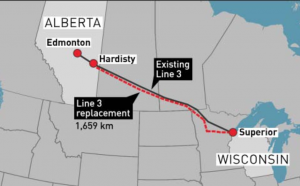Sourced from Life Without Line 3
Line 3 is the single largest project in Enbridge’s history—with the cancellation of Energy East and uncertain financial backing of Kinder Morgan and Keystone XL, Line 3 is a fight that will cripple the industry while changing the narrative of Indigenous peoples within mainstream society.
The existing Line 3 is an Enbridge pipeline that transports tar sands crude oil from Hardisty, A lberta to Superior, Wisconsin, spanning Northern Minnesota and crossing Leech Lake and Fon du Lac reservations and the 1855, 154 and 1842 treaty areas.
lberta to Superior, Wisconsin, spanning Northern Minnesota and crossing Leech Lake and Fon du Lac reservations and the 1855, 154 and 1842 treaty areas.
Costing $7.5 billion, the proposed new Line 3 would be the largest project in Enbridge’s history and one of the largest crude oil pipelines in the world, carrying up to 915,000 barrels per day of one of the dirtiest fuels on earth: crude tar sands.
In a public relations spin, Enbridge calls the new Line 3 a “replacement.” The truth is that the proposed pipeline is larger, transports a higher volume of crude oil, and operates in a completely new corridor. Proposed plans include the construction of 330 miles of new 36-inch diameter pipeline to replace 282 miles of the existing 34-inch Line 3 pipeline in Minnesota.
The proposed new route endangers the Great Lakes, home to one fifth of the world’s fresh water. It also threatens critical resources on Ojibwe treaty lands, where tribal members retain the rights to hunt, fish, gather, hold ceremony, and travel. It is our responsibility as water protectors to prevent this.
Project Status Updates
- As of October 2020, the PUC has (re)approaved the $2.6 billion new line 3 project, though Enbridge is still awaiting other state and federal permits. The original pipeline is oeprating at just 51% of capacity.
- As of July 2020, the canadian portion was in-service, while the U.S. north dakota & minnesota section is in pre-construction phase. An excellent time for intervention.